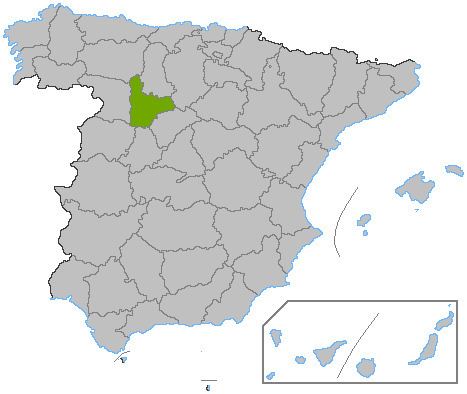 | ||
Valladolid is one of the 52 electoral districts (Spanish: circunscripciones) used for the Spanish Congress of Deputies - the lower chamber of the Spanish Parliament, the Cortes Generales. It is one of the nine electoral districts which correspond to the provinces of Castile and León. Valladolid is the largest municipality accounting for 275,000 voters - nearly two thirds of the total electorate. Medina del Campo and Laguna de Duero are the next largest municipalities although both have less than 20,000 voters.
Contents
- Boundaries and electoral system
- Electoral procedures
- Eligibility
- Number of members
- Summary of seats won 19772008
- Vote share summary 1977 2011
- Results
- 2008 General Election
- 2004 General Election
- References
Valladolid produced a close result in 2004 and was a key PSOE target seat in the 2008 election however in the end the People's Party (PP) increased their lead over the PSOE.
Boundaries and electoral system
Under Article 68 of the Spanish constitution the boundaries must be the same as the province of Valladolid and under Article 140 this can only be altered with the approval of congress. Voting is on the basis of universal suffrage in a secret ballot. The electoral system used is closed list proportional representation with seats allocated using the D'Hondt method. Only lists which poll 3% or more of all valid votes cast, including votes "en blanco" i.e. for "none of the above" can be considered for seats. Under article 12 of the constitution, the minimum voting age is 18.
Electoral procedures
The laws regulating the conduct and administration of elections are laid out in detail in the 1985 electoral law. (Ley Orgánica del Régimen Electoral General.) Under this law, the elections in Valladolid, as in other districts, are supervised by the Electoral Commission (Junta Electoral), a permanent body composed of eight Supreme Court judges and five political scientists or sociologists appointed by the Congress of Deputies. The Electoral commission is supported in its work by the Interior Ministry. On election day, polling stations are run by electoral boards which consist of groups of citizens selected by lottery.
The format of the ballot paper is designed by the Spanish state, however, the law allows political parties to produce and distribute their own ballot papers, either by mailing them to voters or by other means such as street distribution, provided that they comply with the official model. The government then covers the cost of all printed ballot papers. These must then be marked by voters, either in the polling station or outside the polling station and placed inside sealed envelopes which are then placed inside ballot boxes in the polling station. Following the close of polls, the ballots are then counted in each individual polling station in the presence of representatives of the political parties and candidates. The ballots are then immediately destroyed, with the exception of those considered invalid or challenged by the candidates' representatives, which are retained for further scrutiny. The result is that full recounts are impossible.
Eligibility
Article 67.3 of the Spanish Constitution prohibits dual membership of the Cortes and regional assemblies, meaning that candidates must resign from Regional Assemblies if elected. Article 70 also makes active judges, magistrates, public defenders, serving military personnel, active police officers and members of constitutional and electoral tribunals ineligible. Additionally, under Article 11 of the Political Parties Law, June 2002 (Ley Orgánica 6/2002, de 27 de junio, de Partidos Políticos), parties and individual candidates may be prevented from standing by the Spanish Supreme Court (Tribunal Supremo), if they are judged to have violated Article 9 of that law which prohibits parties which are perceived to discriminate against people on the basis of ideology, religion, beliefs, nationality, race, gender or sexual orientation (Article 9a), foment or organise violence as a means of achieving political objectives (Article 9b) or support or compliment the actions of "terrorist organisations" (Article 9c). Article 55, Section 2 of the 1985 electoral law also disqualifies director generals or equivalent leaders of state monopolies and public bodies such as the Spanish state broadcaster RTVE. Lastly, following changes to the electoral law which took effect for the 2007 municipal elections, candidates' lists must be composed of at least 40% of candidates of either gender and each group of five candidates must contain at least two males and two females.
Number of members
Valladolid has returned four members at every election since the restoration of democracy.
Under Spanish electoral law, all provinces are entitled to a minimum of 2 seats with a remaining 248 seats apportioned according to population. These laws are laid out in detail in the 1985 electoral law. (Ley Orgánica del Régimen Electoral General) The practical effect of this has been to overrepreseent smaller provinces at the expense of larger provinces. Valladolid had a ratio of 86,355 voters per deputy in 2004 a figure below the Spanish average of 98,777 voters per deputy.
Summary of seats won 1977–2008
Seats shown for the Peoples Party include seats won by their predecessors the Popular Alliance in 1982 and the Popular Coalition in 1986.
Vote share summary 1977-2011
* Result for 1993 and subsequent elections are those for 'Regional unity for Castille and Leon' (URCL)
Results
Valladolid has usually favoured the parties of the right. The PSOE were only able to top the poll in their best election years of 1982 and 1986. IU have always failed to make an impact here and their vote share declined by 2.4% in the 2004 election, their second biggest decline after Madrid.
2008 General Election
# On 18 July 2008, Rodríguez was replaced by Emilio Álvarez Villazán
Source:
2004 General Election
Source:
